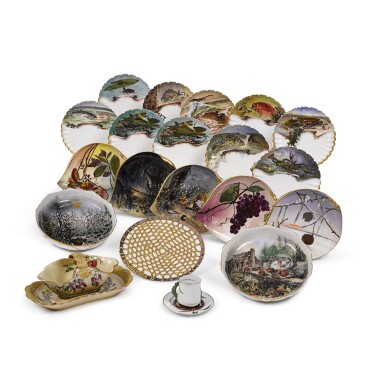Important Americana: Furniture, Folk Art, Silver, Chinese Export Art and Prints
Important Americana: Furniture, Folk Art, Silver, Chinese Export Art and Prints

A Part-Dinner and Coffee Service of President Rutherford B. Hayes State Service-Pattern, Circa 1880
Auction Closed
January 20, 04:11 PM GMT
Estimate
10,000 - 15,000 USD
Lot Details
Description
designed by Theodore Russell Davis (1840–1894), Haviland & Co., Limoges,
comprising:
1 sauceboat;
2 soup plates, Tomato, The Harvest;
10 scalloped-edged seafood salad plates, Terrapin, Blue-Fish, Sheep's-Head, The Pike, Pompano, Red Snapper, Black Bass, Speckled Trout, Fresh-Water Lobster;
2 game or dinner plates, The Mocking-Bird, Teal;
5 leaf-shaped fruit plates, Papaw, The Mocking-Bird, Maple Sugar, The Concord Grape, The Chincapin;
1 'Indian' plate;
and 1 coffee cup and saucer;
painted mark D to most painted scenes, underside of the rim with the United States Seal, H&Co./L mark in green, FABRIQUÈ PAR HAVILAND & Co. d'après les dessins DE mark in orange, Theo: R. Davis. script mark in black, DESIGN PATENTED AUGUST 10TH 1880, No. 1193, 11934 or 11935 in blue, various impressed numerals. 23 pieces.
In 1879, the First Lady Lucy Webb Hayes, at the beginning of the third year of her husband’s, Rutherford B. Hayes’s, presidency, commissioned the French firm Haviland & Co., Limoges to produce a state dinner service. The service comprised 562 pieces for nine courses and after dinner tea and coffee, and had a production cost of $3,120. It is one of the most extraordinary services produced for the White House, radically departing from previous commissions.
The First Lady had initially planned to select a floral pattern for the White House service when she had a chance meeting with American artist Theodore Russell Davis (1840-1894). Davis suggested that instead she opt for depictions of flora and fauna native to North America, and Mrs. Hayes agreed. She commissioned Davis as the designer, and he produced 130 distinct decorations. Upon receiving the first, the First Lady wrote to Davis, "It is a delight to study the beautiful forms and paintings. One almost feels as if such Ceramic Art should be fused for no other purpose except to gratify the eye."
Upon its delivery to the White House, interest in the service from the public was so strong that Davis took out patents to reproduce the individual pieces for public sale. The service is discussed at length by Margaret Brown Klapthor, White House China, 1789 to the Present, New York, 1999, 2nd edition, pp. 102-121.
